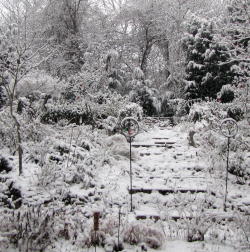.jpg)
.jpg)
.jpg) For the last several years, we have grown this beautiful and delicious vegetable, swiss chard. Here is what Wikipedia has to say about it:
For the last several years, we have grown this beautiful and delicious vegetable, swiss chard. Here is what Wikipedia has to say about it:“Chard (Beta vulgaris var. cicla), also known as Swiss Chard, Silverbeet, Perpetual Spinach, or Mangold, is a leaf vegetable, and is one of the cultivated descendants of the Sea Beet, Beta vulgaris subsp. maritima. While used for its leaves, it is in the same species as the garden beet, which is grown primarily for its roots.
The word Swiss was used to distinguish chard from French spinach varieties by nineteenth century seed catalog publishers. The chard is very popular among Mediterranean cooks. The first varieties have been traced back to Sicily.”
.jpg) We have grown it from seed and purchased seedlings in four packs, as we did last year. This is a plant that is as ornamental as it is edible. Even more ornamental is the ‘Bright Lights’ series of red, yellow, pink and orange stalks and veins. Planted out last year mid March, these wee ones don’t look like much, but just wait. Remember, gardening is about being patient.
We have grown it from seed and purchased seedlings in four packs, as we did last year. This is a plant that is as ornamental as it is edible. Even more ornamental is the ‘Bright Lights’ series of red, yellow, pink and orange stalks and veins. Planted out last year mid March, these wee ones don’t look like much, but just wait. Remember, gardening is about being patient.
.jpg)
By early May, having survived the killing frost of April during Easter weekend, sorry for bringing it up yet again, I just want to sing the praises of the toughness of the chard you see, the stems are elongated and colorful. On the left behind the chard is a parsley plant going to seed. The pink flowers are volunteer poppies, we shall call them bread poppies.
.jpg)
By the end of May, the outer leaves have been harvested. We take those to use in cooking, removing the stems, roughly chopping, quick saute, then into freezer bags to be used for soups, stews, etc. The harvest is repeated throughout the summer, keeping the plants looking fresh and giving us lots of vitamins. The poppies have their adorable seedpod heads, the verbena bonariensis and malva zebrina are blooming. This is a bit of a wild bed, once used as the compost heap for spent flowers so full of seeds they were not allowed in the cleaner compost pile. It is always a surprise what will arise there, the chard lines the front to give it some sense of order.
.jpg) Planted in the above two shots, but so small as to not be visible is a row of Black Pearl pepper babies, grown from saved seed and true to the parent in foliage and fruit color. Still more order is trying to be applied to this bed. This photo was taken in July. Smaller than normal, due to drought, the peppers have grown and the chard is undaunted by the lack of water.
Planted in the above two shots, but so small as to not be visible is a row of Black Pearl pepper babies, grown from saved seed and true to the parent in foliage and fruit color. Still more order is trying to be applied to this bed. This photo was taken in July. Smaller than normal, due to drought, the peppers have grown and the chard is undaunted by the lack of water.
.jpg)
September shows the black, shiny peppers, although the plants are small, the chard has provided many meals and is looking slightly ratty tatty. Salvia coccinea adds some zesty color, looking too pretty to be pulled out, even though it is crowding the peppers.
 The end of the season with a hard frost later in the month. Even now, in February there are healthy leaves, very small but still hanging on, but not for long.
The end of the season with a hard frost later in the month. Even now, in February there are healthy leaves, very small but still hanging on, but not for long.
Soon the old plants will be tossed into the compost bin, for we have the new replacements growing happily in the greenhouse. This group is in the chicken grit, it makes for a clean stem, no seed starting mix splash up to dirty the red stalks, red from the moment of germination. This packet was Ruby Chard, no yellows, pinks or oranges. We love those other colors, but there is a design scheme in the works for this year’s potager, the beautiful vegetable garden.
The front half of this tray is all ruby chard, four sections times nine plants in each gives us thirty six to use in some fancy way in the potager. If you want to know what is in the back four sections, why it is the baby dahlia ‘Bishop’s Children’, a rousing success along with the chard. Don’t you love growing plants from seeds that are so willing to cooperate?
As promised, the long shot, this time of the greenhouse/sunroom south facing shelves, the best exposure for raising the seedlings. The east side contains the orchid shelves, not as intense a light on that side with the sun still fairly low in the horizon, shining directly into these windows. Later this spring the sun will be higher and a large maple tree nearby will give some shade to the greenhouse so the plants don’t cook under glass. The bottom portion of the south facing windows have black plastic screening, the seeds are started on the lower shelves there, then moved to the upper shelves when the time is right for stronger rays to strengthen the plants, readying them for the move outside on warmer days next month. There will be some extra work to get the trays of babies hardened off, in and out, under the glass top table on the deck. By late March the chard will be in the ground. The plan needs to be thought through how to use the red color to maximize it’s beauty potential in relation to the onions, peppers, peas, beans, radishes, carrots, squash and tomatoes. Hmmm, can’t think of design when those veggies are swimming around in my head, pulling the bell to one’s stomach. What’s for dinner?


.jpg)








I don’t know about dinner yet but I must go have breakfast after reading this. I have always loved the look of the look of chard but I wouldn’t know how to prepare it. I have thought I might grow it becasue it is so beautiful.
Lisa…Think of it as tough spinach, a little more cooking but used the same way. The colored stalk types are as pretty as flowers!
Yes, I think now I need a little more than the grapefruit I ate an hour ago…looks delicious! And Frances, thank you so much for your suggestion about using evergreens to lightly protect my hellebore. We had snow again and now we’re back to very cold weather–you just never know what is going to happen here, weatherwise, one day to the next. No wonder I get moody, by times. 🙂
Jodi…Hope the evergreens work, I really don’t have experience with the snow you have to deal with. We do have the very mild followed by frigid (to us) days however, it is an adjustment from day to day just with the clothing choices.
Swiss chard is definitely not something I’d grow as an edible, but there sure are a lot of ornamental choices.
Frances,
I love rainbow and green chard, it is tasty when sauted with other vegies and served over brown rice. I have had green chard is Portuguese Sausage soup…yummy.
I think it might look good in the perennial garden, certainly a strong accent plant and the colors are super.
gail
Love swiss chard, both in the ornamental border and the veggie garden! Yours are so prettily planted!
Sold! I’m going to buy some Swiss chard seeds right now. I had excellent results overwintering spinach under a floating row cover and I’m looking to expand on that idea. And chard is way prettier than spinach.
“While used for its leaves, it is in the same species as the garden beet, which is grown primarily for its roots.”
True, but sad because beet greens make a fine addition to any green salad, and a few leaves snipped here and there now and then make little difference to the root.
And I assume they are highly nutritious. Guy won’t eat beets, but he’ll eat a salad with some beet greens mixed in.
And I want to ask why some of your seedlings are coming up from perlite, and others from mix. What’s going on there?
I am not in love with the taste of Swiss Chard. It just tastes like it is good for you, and it is. But, your photos are wonderful. They show that not only is it edible, but beautiful as well.~~Dee
This post makes me want to grow swiss chard. You can’t ask much more of a plant than being both beautiful and yummy 🙂
I just felt little glimmers of excitement seeing your seed-starting operation underway.
The chard is such a beautiful colour – it was the first veggie I ever grew – although not this colourful one. I can well imagine growing this in flower beds and bending down and chomping on the odd leaf now and again.
I’m curious to see what happens with your potager this year!
Thanks for your lovely comment Frances!
This is my first year to grow chard but I love the way it looks. We haven’t started harvesting it (except that I’ve nibbled a leaf or two in the garden). I keep trying to take a good photo of it but yours looks nicer. Thanks for sharing.
Yumm… I grew the ‘Rhubarb’ (ruby) chard two years ago, and am still kicking myself for not growing it again last year. Your pictures are reminding me how beautiful it was–not just tasty, sauteed with olive oil and garlic… mmmm.
Chard is so lovely, isn’t it?!?! And you’ve done a fantastic job of showcasing this veggie garden beauty.
Cindy at Rosehaven Cottage
Enjoyed this post! I used to grow Swiss chard years ago, and this year it will be making a comeback in my garden….Thanks!
Tina…Even if you don’t eat it, the colorful chard makes a good addition to the ornamental garden.
Gail…I agree, the soup sounds delish. The chard has something for everyone.
Layanee…Thanks. This is plant that is easy and lovely.
Entangled…The chard and spinach are very similar in taste, but those colored stems add a lot to the garden’s attractiveness.
chuck b…Beet greens are one of nature’s greatest gifts, maybe Guy would like the chard?
Dee… Welcome. Think of it as an acquired taste, but still lovely even if you don’t eat it.
Brianna…Yes, it fits the bill of the beautiful vegetable garden we are trying for this year.
Kate…Thanks, excitement is our aim. The rabbits also like to nibble it when young. There are high hopes for the potager.And you are most welcome.
Melissa…Thanks and welcome. Interesting plant, this chard.
Black swamp girl…welcome. And what isn’t delicious with garlic and olive oil? ;->
Cindy…Thanks and welcome. I love this veggie, it is very rewarding.
Connie…Welcome and thanks. Hope you have great success with the chard.
chuck b…You are very observant. Some were topped with vermiculite, some with chicken grit. It is an experiment. I like the grit better but it is much more expensive. Better to use it with the special seeds.
Yum. We planted chard for the first time last summer and now we can’t do without it. Our little patch of it kept plugging away all summer and well into the winter. I think we could still scrounge some up from out there!
Meg…Welcome! Our swiss chard was finally pulled out yesterday, it still had some usuable leaves on it. The replacements are doing well inside and will go out mid March, so only one month without it. Pretty good for a veggie!
Interesting to read about your swiss chard – it looks lovely too!
TopVeg…Welcome and thanks!